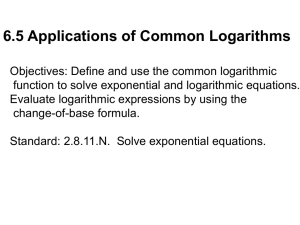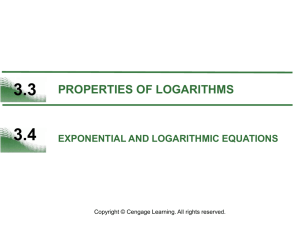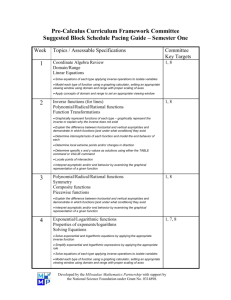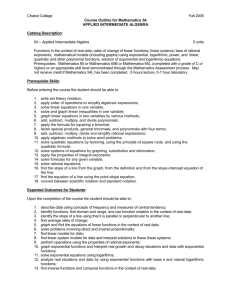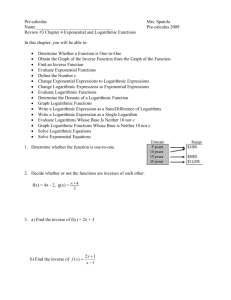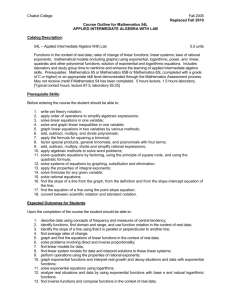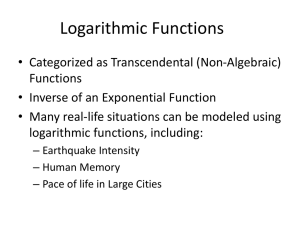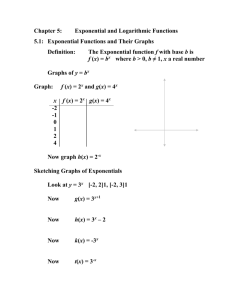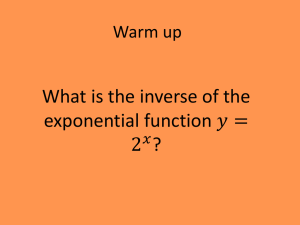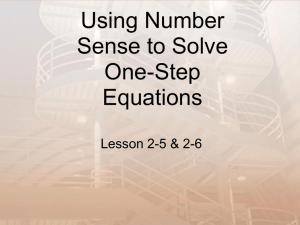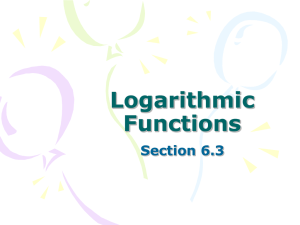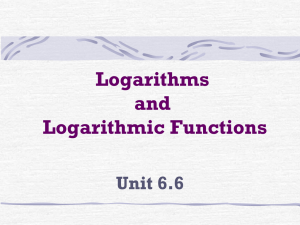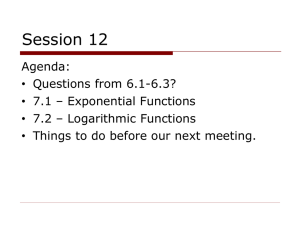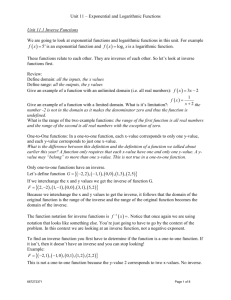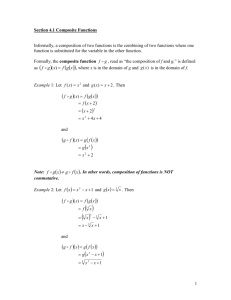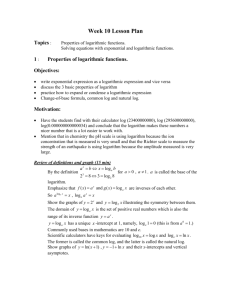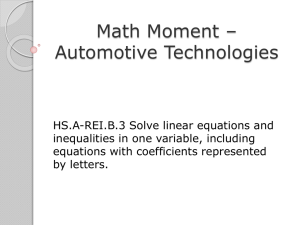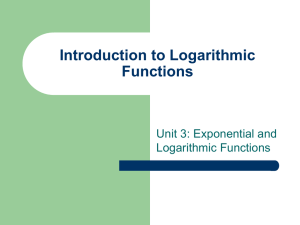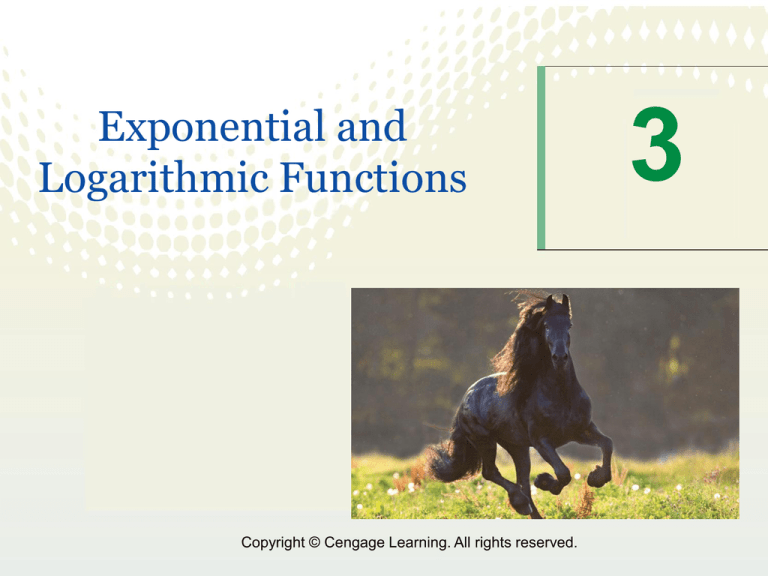
Exponential and
Logarithmic Functions
Copyright © Cengage Learning. All rights reserved.
3
3.4
EXPONENTIAL AND LOGARITHMIC EQUATIONS
Copyright © Cengage Learning. All rights reserved.
What You Should Learn
• Solve simple exponential and logarithmic
equations.
• Solve more complicated exponential equations.
• Solve more complicated logarithmic equations.
• Use exponential and logarithmic equations to
model and solve real-life problems.
3
Introduction
4
Introduction
There are two basic strategies for solving exponential or
logarithmic equations.
The first is based on the One-to-One Properties and was
used to solve simple exponential and logarithmic
equations.
The second is based on the Inverse Properties. For a > 0
and a ≠ 1, the following properties are true for all x and y
for which loga x and loga y are defined.
5
Introduction
One-to-One Properties
ax = ay if and only if x = y.
loga x = loga y if and only if x = y.
Inverse Properties
aloga x = x
loga ax = x
6
Example 1 – Solving Simple Equations
Original
Equation
Rewritten
Equation
Solution
a. 2x = 32
2x = 25
x=5
One-to-One
b. ln x – ln 3 = 0
ln x = ln 3
x=3
One-to-One
c.
3–x = 32
x = –2
One-to-One
d. ex = 7
ln ex = ln 7
x = ln 7
Inverse
e. ln x = –3
eln x = e–3
x = e–3
Inverse
f. log x = –1
10log x = 10–1
x = 10–1 =
Inverse
g. log3 x = 4
3log3 x = 34
x = 81
Inverse
=9
Property
7
Introduction
The strategies used in Example 1 are summarized as
follows.
8
Solving Exponential Equations
9
Example 2 – Solving Exponential Equations
Solve each equation and approximate the result to three
decimal places, if necessary.
2
a. e –x = e –3x – 4
b. 3(2x) = 42
10
Example 2(a) – Solution
2
–x
e
= e –3x – 4
–x2 = –3x – 4
x2 – 3x – 4 = 0
Write original equation.
One-to-One Property
Write in general form.
(x + 1)(x – 4) = 0
Factor.
(x + 1) = 0
x = –1
Set 1st factor equal to 0.
(x – 4) = 0
x=4
Set 2nd factor equal to 0.
The solutions are x = –1 and x = 4. Check these in the
original equation.
11
Example 2(b) – Solution
3(2x) = 42
2x = 14
log2 2x = log2 14
cont’d
Write original equation.
Divide each side by 3.
Take log (base 2) of each side.
x = log2 14
Inverse Property
x=
Change-of-base formula
3.807
The solution is x = log2 14 3.807. Check this in the
original equation.
12
Solving Logarithmic Equations
13
Solving Logarithmic Equations
To solve a logarithmic equation, you can write it in
exponential form.
ln x = 3
Logarithmic form
eln x = e3
Exponentiate each side.
x = e3
Exponential form
This procedure is called exponentiating each side of an
equation.
14
Example 6 – Solving Logarithmic Equations
a. ln x = 2
Original equation
eln x = e2
Exponentiate each side.
x = e2
Inverse Property
b. log3(5x – 1) = log3(x + 7)
5x – 1 = x + 7
4x = 8
x=2
Original equation
One-to-One Property
Add –x and 1 to each side.
Divide each side by 4.
15
Example 6 – Solving Logarithmic Equations
c. log6(3x + 14) – log6 5 = log6 2x
cont’d
Original equation
Quotient Property of Logarithms
One-to-One Property
3x + 14 = 10x
–7x = –14
x=2
Cross multiply.
Isolate x.
Divide each side by –7.
16
Applications
17
Example 10 – Doubling an Investment
You have deposited $500 in an account that pays 6.75%
interest, compounded continuously. How long will it take
your money to double?
Solution:
Using the formula for continuous compounding, you can
find that the balance in the account is
A = Pert
A = 500e0.0675t.
18
Example 10 – Solution
cont’d
To find the time required for the balance to double, let
A = 1000 and solve the resulting equation for t.
500e0.0675t = 1000
e0.0675t = 2
ln e0.0675t = ln 2
0.0675t = ln 2
Let A = 1000.
Divide each side by 500.
Take natural log of each side.
Inverse Property
t=
Divide each side by 0.0675.
t 10.27
Use a calculator.
19
Example 10 – Solution
cont’d
The balance in the account will double after approximately
10.27 years. This result is demonstrated graphically in
Figure 3.31.
Figure 3.31
20



